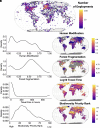From biologging to conservation: Tracking individual performance in changing environments
- PMID: 40720657
- PMCID: PMC12337290
- DOI: 10.1073/pnas.2410947122
From biologging to conservation: Tracking individual performance in changing environments
Abstract
Under an accelerating biodiversity crisis, increased urbanization, habitat fragmentation, and climate change require new approaches to assess conservation impact. We argue that animal biologging is a cost-effective method for monitoring biodiversity at its source, including tracked animals and the habitats they occupy. Biologging, or animal-mounted sensors to record data, can act as a reporting, measurement, and verification system, and deliver direct insights into environments of selection. Using a case study of migrating white storks (Ciconia ciconia), we show that biologging yields real-time measurements of individual performance, mechanistic insights into environments of selection, and the potential for gene flow across anthropogenically influenced habitats. These insights can inform the success of biodiversity targets and conservation initiatives and improve real-time species management. At the global scale, we further illustrate that biologging studies display substantial bias in the types of environments and human conditions sampled. Studies appear biased toward sparsely populated areas and remain particularly rare in highly urbanized areas, areas experiencing high rates of recent forest fragmentation, and key areas for global biodiversity conservation efforts. We highlight the need for equitable access to technology to leverage the biodiversity potential of biologging in the Global South. Advances in software-defined tracking technology will soon give real-time information on energy budgets, survival, reproduction, and ultimately demographic processes and population-level parameters. When deployed into areas most needed, biologging can operationalize access to key measures of biodiversity maintenance such as gene flow, especially in difficult-to-access areas that are key to the future persistence of a species.
Keywords: animal behavior; biodiversity; conservation; global conservation targets; movement ecology.
Conflict of interest statement
Competing interests statement:The authors declare no competing interest.
Figures



Similar articles
-
A scoping review of tropical pioneer trees' roles for restoration and conservation management: Harungana madagascariensis (Hypericaceae) a widespread African species as a model.PeerJ. 2025 May 23;13:e19458. doi: 10.7717/peerj.19458. eCollection 2025. PeerJ. 2025. PMID: 40421372 Free PMC article.
-
Integrating plot-based methods for monitoring biodiversity in island habitats under the scope of BIODIVERSA + project BioMonI: Tree monitoring in Terceira, Tenerife and Réunion Islands.Biodivers Data J. 2025 Jun 23;13:e158423. doi: 10.3897/BDJ.13.e158423. eCollection 2025. Biodivers Data J. 2025. PMID: 40708791 Free PMC article.
-
Habitat dynamics of flagship species for conservation prioritization in southern Europe.Conserv Biol. 2025 Aug;39(4):e70067. doi: 10.1111/cobi.70067. Epub 2025 May 21. Conserv Biol. 2025. PMID: 40396461 Free PMC article.
-
Sexual Harassment and Prevention Training.2024 Mar 29. In: StatPearls [Internet]. Treasure Island (FL): StatPearls Publishing; 2025 Jan–. 2024 Mar 29. In: StatPearls [Internet]. Treasure Island (FL): StatPearls Publishing; 2025 Jan–. PMID: 36508513 Free Books & Documents.
-
Signs and symptoms to determine if a patient presenting in primary care or hospital outpatient settings has COVID-19.Cochrane Database Syst Rev. 2022 May 20;5(5):CD013665. doi: 10.1002/14651858.CD013665.pub3. Cochrane Database Syst Rev. 2022. PMID: 35593186 Free PMC article.
Cited by
-
Synergies between speciation and conservation science yield novel insights for mitigating the biodiversity crisis of the Anthropocene.Proc Natl Acad Sci U S A. 2025 Aug 5;122(31):e2500713122. doi: 10.1073/pnas.2500713122. Epub 2025 Jul 28. Proc Natl Acad Sci U S A. 2025. PMID: 40720642 Free PMC article. No abstract available.
References
-
- Díaz S., et al. , Pervasive human-driven decline of life on Earth points to the need for transformative change. Science 366, eaax3100 (2019). - PubMed
-
- Convention on Biological Diversity, First draft of the Post-2020 Global Biodiversity Framework CBD/WG2020/3/3 (2021).
-
- de Wit L. A., et al. , Co-benefits from species-level conservation contribute to multilateral environmental agreement targets. Conserv. Lett. 18, e13072 (2025), 10.1111/conl.13072. - DOI
-
- Watson J. E. M., Dudley N., Segan D. B., Hockings M., The performance and potential of protected areas. Nature 515, 67–73 (2014). - PubMed
-
- Pringle R. M., Upgrading protected areas to conserve wild biodiversity. Nature 546, 91–99 (2017). - PubMed
MeSH terms
Grants and funding
LinkOut - more resources
Full Text Sources

